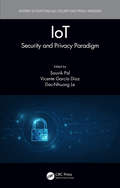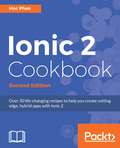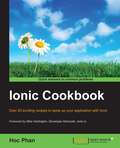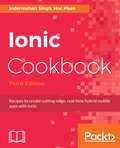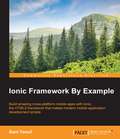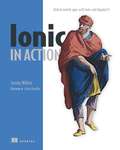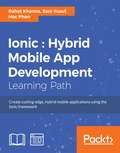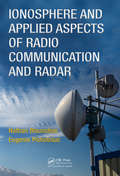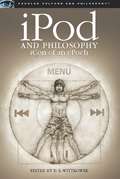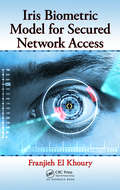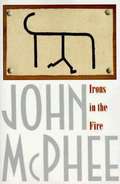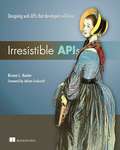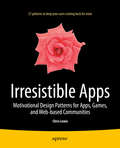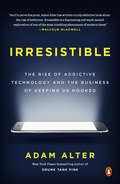- Table View
- List View
IoT: Security and Privacy Paradigm (Internet of Everything (IoE) #63)
by Dac-Nhuong Le Vicente García Díaz Souvik PalIOT: Security and Privacy Paradigm covers the evolution of security and privacy issues in the Internet of Things (IoT). It focuses on bringing all security and privacy related technologies into one source, so that students, researchers, and practitioners can refer to this book for easy understanding of IoT security and privacy issues. This edited book uses Security Engineering and Privacy-by-Design principles to design a secure IoT ecosystem and to implement cyber-security solutions. This book takes the readers on a journey that begins with understanding the security issues in IoT-enabled technologies and how it can be applied in various aspects. It walks readers through engaging with security challenges and builds a safe infrastructure for IoT devices. The book helps readers gain an understand of security architecture through IoT and describes the state of the art of IoT countermeasures. It also differentiates security threats in IoT-enabled infrastructure from traditional ad hoc or infrastructural networks, and provides a comprehensive discussion on the security challenges and solutions in RFID, WSNs, in IoT. This book aims to provide the concepts of related technologies and novel findings of the researchers through its chapter organization. The primary audience includes specialists, researchers, graduate students, designers, experts and engineers who are focused on research and security related issues. Souvik Pal, PhD, has worked as Assistant Professor in Nalanda Institute of Technology, Bhubaneswar, and JIS College of Engineering, Kolkata (NAAC "A" Accredited College). He is the organizing Chair and Plenary Speaker of RICE Conference in Vietnam; and organizing co-convener of ICICIT, Tunisia. He has served in many conferences as chair, keynote speaker, and he also chaired international conference sessions and presented session talks internationally. His research area includes Cloud Computing, Big Data, Wireless Sensor Network (WSN), Internet of Things, and Data Analytics. Vicente García-Díaz, PhD, is an Associate Professor in the Department of Computer Science at the University of Oviedo (Languages and Computer Systems area). He is also the editor of several special issues in prestigious journals such as Scientific Programming and International Journal of Interactive Multimedia and Artificial Intelligence. His research interests include eLearning, machine learning and the use of domain specific languages in different areas. Dac-Nhuong Le, PhD, is Deputy-Head of Faculty of Information Technology, and Vice-Director of Information Technology Apply and Foreign Language Training Center, Haiphong University, Vietnam. His area of research includes: evaluation computing and approximate algorithms, network communication, security and vulnerability, network performance analysis and simulation, cloud computing, IoT and image processing in biomedical. Presently, he is serving on the editorial board of several international journals and has authored nine computer science books published by Springer, Wiley, CRC Press, Lambert Publication, and Scholar Press.
Ion Beam Induced Defects and Their Effects in Oxide Materials (SpringerBriefs in Physics)
by Vinod Kumar Parmod Kumar Jitendra Pal Singh K. AsokanThis book provides an overview of the applications of ion beam techniques in oxide materials. Oxide materials exhibit defect-induced physical properties relevant to applications in sensing, optoelectronics and spintronics. Defects in these oxide materials also lead to magnetism in non-magnetic materials or to a change of magnetic ordering in magnetic materials. Thus, an understanding of defects is of immense importance. To date, ion beam tools are considered the most effective techniques for producing controlled defects in these oxides. This book will detail the ion beam tools utilized for creating defects in oxides.
Ionic 2 Blueprints
by Indermohan SinghBuild real-time, scalable, and interactive mobile apps with the Ionic framework About This Book * Create amazing, cross-platform hybrid native apps using a projects-based approach * Discover ways to make the best use of the latest features in Ionic to build on a wide array of applications * This is the right learning curve for you if you want to take the leap from an intermediate-level to a pro front-end developer with Ionic Who This Book Is For This book is for intermediate-level Ionic developers who have some experience in working with Ionic, but don't yet have a complete idea how powerful Ionic can be to create real-time apps with dynamic functionality. What You Will Learn * Get to grips with the features of Ionic for application development * Build a Chat app with Firebase and Ionic * Make a stock tracking app using the third-party REST API and build its layouts with Ionic Navigation and Pages * Use Cordova plugins with Ionic to build a media player app * Create a production-ready application by using Ionic components, services, and Firebase as a back end * Get to know the best practices to create real-time Ionic applications In Detail Ionic 2, the latest version of Ionic Mobile SDK, is built on the top of latest technologies such as Angular 2, TypeScript, SASS, and lot more. The idea behind Ionic 2 is to make the entire app development process even more fun. This book makes it possible to build fun and engaging apps using Ionic 2. You will learn how to use various Ionic components, integrate external services, derive capabilities, and most importantly how to make professional apps with Ionic 2. It will help you in understanding the fundamentals of Ionic 2 app development and will show how to build applications, gradually increasing your capabilities and the complexity of applications so that you can learn Ionic app development in a consistent and convenient way. You will also explore services such as Firebase, using LocalStorage, the WordPress JSON API, and REST API, which will help you turn your next billion dollar idea into reality. By the end of this book, you will be able to proudly call yourself a pro Ionic developer who can create a host of different apps with Ionic, and you'll have a deeper practical understanding of Ionic. Style and approach A practical project-based approach helps you create five-six different apps on your own using the various features of Ionic in each project.
Ionic 2 Cookbook - Second Edition
by Hoc PhanOver 30 life-changing recipes to help you create cutting edge, hybrid apps with Ionic 2 About This Book * Leverage Ionic 2 and its exciting new features to create cutting edge real-time apps * Work through simple recipes to address your problems directly and solve them effectively * Get examples at each step to guide you on your learning curve Who This Book Is For This book is for front end JavaScript developers who know the basics of JavaScript programming. No prior knowledge of Ionic is required to get the most of this book. What You Will Learn * Create custom UIs using Angular 2 directives * Make the best use of REST APIs to submit forms * Create beautiful animations and graphics in the application * Embed videos and other media into the app * Access native device functionalities such as a camera and maps using ngCordova * Theme the application based on the various platform styles available * Publish your application to a variety of platforms * Leverage Angular 2 events and Ionic-specific events to communicate In Detail Developing real-time apps is the need of the hour, and apps that deal with humongous amounts of user data and real-time information that needs to be updated frequently are in high demand. Currently, one of the most popular frameworks for this task is Ionic Framework, which is undergoing a major makeover. This book will get you started with Ionic and help you create Angular 2 components that interact with templates. From there, you'll work with Ionic components and find out how to share data efficiently between them. You'll discover how to make the best use of the REST API to handle back-end services and then move on to animating the application to make it look pretty. You'll learn to add in a local push notification in order to test the app. You'll work with Cordova to support native functionalities on both iOS and Android. From there, you'll get to grips with using the default themes for each platform as well as customizing your own. Finally, you'll see how best to deploy your app to different platforms. This book will solve all your Ionic-related issues through dedicated recipes that will help you get the best out of Ionic. Style and approach This book is a recipe-based solution to all your Ionic 2 related problems and will help you create cutting edge real-time apps with ease through simple-to-understand step-by-step recipes.
Ionic Cookbook
by Hoc PhanOver 35 exciting recipes to spice up your application development with IonicAbout This BookLearn how to utilize the robust features of Ionic CLI and its framework to create, develop, and build your mobile appExplore new integrations with various Backend-as-a-Services, along with AngularJS modules, for creative solutionsUse out-of-the-box Ionic functionalities, customize existing components, and add new components with this comprehensive, step-by-step guideWho This Book Is ForIf you are a front-end developer and want to take advantage of your existing mobile application development skills to develop cross-platform mobile apps, this book is for you. You will build up your Ionic knowledge with in-depth recipes on Angular.js, Cordova, and Sass.What You Will LearnAuthenticate users using an e-mail password, Twitter, Facebook, Google+, and LinkedInRetrieve data and store it using FirebaseAccess native device functionalities such as a camera, contact list, e-mail, and maps using ngCordovaWork with localStorage and SQLite for persistent data access on the client sideCommunicate to and from your app using push notifications or SMSLeverage AngularJS events and Ionic-specific events to communicate across pages, controllers, and directivesCustomize the color and theme of your Ionic appCreate new custom directives as componentsCompile your app for iOS, Android, and Windows PhoneIn DetailThe world of mobile development is extremely fragmented with many platforms, frameworks, and technologies available. Ionic is intended to fill that gap, by enabling developers to build apps that have a native feel to them, using web technologies such as HTML, CSS, and AngularJS. Ionic makes it easy for front-end developers to become app developers. The framework provides superior performance with deep Cordova integration and a comprehensive set of tools for prototyping, backend support, and deployment.Ionic Cookbook takes you through the process of developing a cross-platform mobile app using just HTML5 and the JavaScript-based Ionic.You will start with an introduction to the CLI and then move on to building and running an app. You will explore common features of real-world mobile apps such as authenticating a user, and getting and saving data using either Firebase or Local Storage. Next, the book covers how Ionic integrates with Cordova to support native device features using ngCordova, and you will discover how to take advantage of existing modules around its ecosystem. You will also delve into advanced topics, including how to extend Ionic to create new components. Finally, the book will walk you through customizing the Ionic theme and building the app so that it can be deployed to all platforms.Style and approachThis book follows a recipe-based approach to cross-platform mobile app development, where each task is explained in a conversational and easy-to-follow style. Every topic explains individual features or components of Ionic, and provides extra details for readers to come up with custom solutions based on real-world applications.
Ionic Cookbook: Recipes to create cutting-edge, real-time hybrid mobile apps with Ionic, 3rd Edition
by Indermohan SinghSolve all your Ionic-related issues through dedicated recipes that will help you get the best out of Ionic. Working with Ionic components to find out the best way to share data between them effectively.Key Features-Leverage Ionic 3.9 and its exciting new features to create cutting-edge, real-time apps -Work through simple recipes to address your problems directly and solve them effectively -Get examples at each step to guide you on your learning curve with AngularBook DescriptionIonic is the preferred choice for JavaScript developers to develop real-time hybrid applications. This book will get you started with Ionic 3.9 and help you create Angular 5 components that interact with templates. You will work with Ionic components and find out how to share data efficiently between them. You'll discover how to make the best use of the REST API to handle back-end services and then move on to animating your application to make it look pretty. You then learn to add in a local push notification in order to test the app. Then you'll work with Cordova to support native functionalities on both iOS and Android. From there, you'll get to grips with using the default themes for each platform and customizing your own. We then take you through the advanced Ionic features like lazy loading, deep linking, localizing ionic apps etc. Finally, you'll see how best to deploy your app to different platforms. This book will solve all your Ionic-related issues through dedicated recipes that will help you get the best out of Ionic.What you will learn-Help readers to jump-start Ionic apps-Explore essential features of Ionic with examples-Learn how to use native device functionalities-Make the best use of the REST API to handle back-end services -Work with Cordova to support native functionalities on both iOS and Android.-Master advanced topics in app development such as deep linking and lazy loadingWho this book is forThis book targets JavaScript developers. No previous knowledge of Ionic is necessary, but prior knowledge of web development techniques would be useful.
Ionic Framework By Example
by Sani YusufThis book is for anyone who wants to see Ionic in action - and find out how it could transform the way they build mobile apps. If you're a JavaScript web developer, you'll be building great projects in no time.
Ionic in Action: Hybrid Mobile Apps with Ionic and AngularJS
by Jeremy WilkenSummaryIonic in Action teaches web developers how to build cross-platform mobile apps for phones and tablets on iOS and Android. You'll learn how to extend your web development skills to build apps that are indistinguishable from native iOS or Android projects.Purchase of the print book includes a free eBook in PDF, Kindle, and ePub formats from Manning Publications.About the BookWouldn't it be great if you could build mobile apps using just your web development skills? With Ionic, you can do just that: create hybrid mobile apps using web technologies that you already know, like HTML, CSS, and JavaScript, that will run on both iOS and Android.Ionic in Action teaches web developers how to build mobile apps using Ionic and AngularJS. Through carefully explained examples, the book shows you how to create apps that use UI components designed for mobile, leverage current location, integrate with native device features like the camera, use touch gestures, and integrate with external data sources. Learn to test your apps to improve stability and catch errors as you develop. Finally, you'll discover the command-line utility, and how to build and deploy to app stores.What's InsideCreate mobile apps with HTML, JavaScript, and CSSDesign complex interfaces with Ionic's UI controlsBuild once and deploy for both iOS and AndroidUse native device hardware and device-specific featuresCovers the entire mobile development processAbout the ReaderReaders should know HTML, CSS, and JavaScript. Familiarity with AngularJS is helpful but not required.About the AuthorJeremy Wilken is a senior UX software developer who works with Ionic, AngularJS, and Node.js. He lives in Austin, Texas.Table of ContentsIntroducing Ionic and hybrid appsSetting up your computer to build appsWhat you need to know about AngularJSIonic navigation and core componentsTabs, advanced lists, and form componentsWeather app, using side menus, modals, action sheets, and ionScrollAdvanced techniques for professional appsUsing Cordova pluginsPreviewing, debugging, and automated testingBuilding and publishing apps
Ionic: Hybrid Mobile App Development
by Hoc Phan Rahat Khanna Sani YusufAn end–to-end journey, empowering you to build real-time, scalable, and interactive mobile applications with the Ionic framework About This Book • Develop engaging mobile experiences with a native-looking UI in Ionic and AngularJS. • Use out-of-the-box Ionic functionalities, customize existing components, and add new components with this comprehensive course. • Learn Ionic by creating three complete mobile applications Who This Book Is For If you are a web developer who wants to build hybrid mobile app development using the Ionic framework, then this comprehensive course is best-suited for you. What You Will Learn • Get to know about Hybrid Apps and AngularJS • Set up a development environment to build Hybrid Apps • Navigate around components and routing in Ionic • Authenticate users using an e-mail password, Twitter, Facebook, Google+, and LinkedIn • Retrieve data and store it using Firebase • Access native device functionalities such as the camera, contact list, e-mail, and maps using NG-Cordova • Integrate PhoneGap plugins with NG-Cordova • Test your apps to improve and optimize performance In Detail Hybrid Apps are a promising choice in mobile app development to achieve cost-effectiveness and rapid development. Ionic has evolved as the most popular choice for Hybrid Mobile App development as it tends to match the native experience and provides robust components/tools to build apps. The Ionic Complete Developers course takes you on an end–to-end journey, empowering you to build real-time, scalable, and interactive mobile applications with the Ionic framework. Starting with an introduction to the Ionic framework to get you up and running, you will gradually move on to setting up the environment, and work through the multiple options and features available in Ionic to build amazing hybrid mobile apps. You will learn how to use Cordova plugins to include native functionality in your hybrid apps. You will work through three complete projects and build a basic to-do list app, a London tourist app, and a complete social media app. All three projects have been designed to help you learn Ionic at its very best. From setting up your project to developing on both the server side and front end, and best practices for testing and debugging your projects, you'll quickly be able to deliver high-performance mobile apps that look awesome. You will then hone your skills with recipes for cross-platform development. Integrating Ionic with Cordova will bring you native device features, and you will learn about the best modules from its ecosystem. Creating components and customizing the theme will allow you to extend Ionic. You'll see how to build your app to deploy to all platforms to make you a confident start-to-finish mobile developer. This Learning Path combines some of the best that Packt has to offer in one complete, curated package. It includes content from the following Packt products: • Getting Started with Ionic – by Rahat Khanna • Ionic by Example – by Sani Yusuf • Ionic Cookbook – by Hoc Phan Style and approach This course shows you how to get up and running with the Ionic framework. It doesn't just give you instructions, expecting you to follow them. Instead, with a hands-on approach, it demonstrates what Ionic is capable of through a series of practical projects that you can build yourself.
Ionosphere and Applied Aspects of Radio Communication and Radar
by Nathan Blaunstein Eugeniu PlohotniucA Complete Reference for the 21st CenturyUntil recently, much of the communications technology in the former Eastern bloc countries was largely unknown. Due to the historically competitive nature of East/West relations, scientific groups operated independently, without the benefit of open communication on theoretical framework
Ipod and Philosophy: Icon of an Epoch
by Dylan E. WittkowerNineteen readings examine the social impact of this popular mobile digital device. Approaching hearing as a social act and technology from a Marxist perspective, Wittkower (philosophy, Coastal Carolina U.) asks questions about the relationship between the music we hear via the iPod, the artist, the "i" (self), and iPublic. Other contributors approach the iPod as creating a familiarity in a Wittgensteinian sense, as a new venue for philosophy audiobooks, and as a tool of white dominance, community, or isolation.
Iris Analysis for Biometric Recognition Systems
by Rajesh M. Bodade Sanjay N. TalbarThe book presents three most significant areas in Biometrics and Pattern Recognition. A step-by-step approach for design and implementation of Dual Tree Complex Wavelet Transform (DTCWT) plus Rotated Complex Wavelet Filters (RCWF) is discussed in detail. In addition to the above, the book provides detailed analysis of iris images and two methods of iris segmentation. It also discusses simplified study of some subspace-based methods and distance measures for iris recognition backed by empirical studies and statistical success verifications.
Iris Biometric Model for Secured Network Access
by Franjieh El KhouryIn the last few years, biometric techniques have proven their ability to provide secure access to shared resources in various domains. Furthermore, software agents and multi-agent systems (MAS) have shown their efficiency in resolving critical network problems. Iris Biometric Model for Secured Network Access proposes a new model, the IrisCryptoAgen
IronPython in Action
by Christian J. Muirhead Michael FoordIn 2005, Microsoft quietly announced an initiative to bring dynamic languages to the .NET platform. The starting point for this project was a .NET implementation of Python, dubbed IronPython. After a couple years of incubation, IronPython is ready for real-world use. It blends the simplicity, elegance, and dynamism of Python with the power of the .NET framework.IronPython in Action offers a comprehensive, hands-on introduction to Microsoft's exciting new approach for programming the .NET framework. It approaches IronPython as a first class .NET language, fully integrated with the .NET environment, Visual Studio, and even the open-source Mono implementation. You'll learn how IronPython can be embedded as a ready-made scripting language into C# and VB.NET programs, used for writing full applications or for web development with ASP. Even better, you'll see how IronPython works in Silverlight for client-side web programming.IronPython opens up exciting new possibilities. Because it's a dynamic language, it permits programming paradigms not easily available in VB and C#. In this book, authors Michael Foord and Christian Muirhead explore the world of functional programming, live introspection, dynamic typing and duck typing , metaprogramming, and more.IronPython in Action explores these topics with examples, making use of the Python interactive console to explore the .NET framework with live objects. The expert authors provide a complete introduction for programmers to both the Python language and the power of the .NET framework. The book also shows how to extend IronPython with C#, extending C# and VB.NET applications with Python, using IronPython with .NET 3.0 and Powershell, IronPython as a Windows scripting tool, and much more. Purchase of the print book comes with an offer of a free PDF, ePub, and Kindle eBook from Manning. Also available is all code from the book.
Irons in the Fire
by John McpheeAnother of McPhee's anthologies of well-written, highly informed, and very enjoyable essays that originally appeared in the New Yorker magazine. Joihn McPhee has a talent for making any subject interesting, and the diversity of the subjects he shares with his readers just in this book is astounding - from branding cattle to mountains made of tires to forensic geology to Plymouth Rock, and more.
Irregularities and Prediction of Major Disasters
by Yi Lin Shoucheng OuYangAlthough scientists have effectively employed the concepts of probability to address the complex problem of prediction, modern science still falls short in establishing true predictions with meaningful lead times of zero-probability major disasters. The recent earthquakes in Haiti, Chile, and China are tragic reminders of the critical need for
Irresistible APIs: Designing web APIs that developers will love
by Kirsten HunterSummaryA Web API is a platform with a web-style interface developers can use to implement functionality. Well-designed APIs feel like a natural extension of the application, rather than just a new interface into the backend database. Designing Web APIs based on use cases allows an organization to develop irresistible APIs, which developers can consume easily and which support the business values of that organization.Purchase of the print book includes a free eBook in PDF, Kindle, and ePub formats from Manning Publications.About the TechnologyIt takes a village to deliver an irresistible web API. Business stakeholders look for an API that works side-by-side with the main product to enhance the experience for customers. Project managers require easy integration with other products or ways for customers to interact with your system. And, developers need APIs to consistently interoperate with external systems. The trick is getting the whole village together. This book shows you how.About the BookIrresistible APIspresents a process to create APIs that succeed for all members of the team. In it, you'll learn how to capture an application's core business value and extend it with an API that will delight the developers who use it. Thinking about APIs from the business point of view, while also considering the end-user experience, encourages you to explore both sides of the design process and learn some successful biz-to-dev communication patterns. Along the way, you'll start to view your APIs as part of your product's core value instead of just an add-on.What's InsideDesign-driven developmentDeveloping meaningful use casesAPI guiding principlesHow to recognize successful APIsAbout the ReaderWritten for all members of an API design team, regardless of technical level.About the AuthorKirsten Hunter is an API evangelist who helps developers and business stakeholders understand, design, and deliver amazing APIs.Table of ContentsUNDERSTANDING WEB APIsWhat makes an API irresistible?Working with web APIsAPI FirstWeb services explainedDESIGNING WEB APIsGuiding principles for API designDefining the value for your APICreating your schema modelDesign-driven developmentEmpowering your developers
Irresistible Apps
by Chris LewisThis practical guide provides a comprehensive overview of professionally managed assets, or investments in which all portfolio decisions and rebalancing are delegated to a fund manager or third-party advice service. Savvy investors looking to achieve a better understanding of the nuances, benefits, and drawbacks of using these products?will find the answers they are looking for in?The Handbook of Professionally Managed Assets, ?no matter whether they would like to learn more about mutual funds or hedge funds. There is a considerable lack of knowledge among the investing public about how to properly construct a well-diversified portfolio of investments that includes a selection of professionally managed assets. As a long-standing financial planner, attorney, and educator, Keith Fevurly remedies this issue in The Handbook of Professionally Managed Assets?by clearly presenting the major categories of professionally managed assets and revealing the best tactics for investing in these vehicles. Along the way, he reveals each asset''s risks and rewards, and he also provides the in-depth knowledge and information investors need to confidently select the right assets for their portfolios. Filled with valuable insights for everyone from financial professionals to individual investors, The Handbook of Professionally Managed Assets?stands alone in its ability to shed light on the many investment vehicles that fall under the larger umbrella of professionally managed assets. With topics as wide-ranging as mutual funds, closed-end funds, unit investment trusts, exchange traded funds, hedge funds, managed futures, and more, this invaluable resource will give you the information you need to build a prosperous financial future for yourself and your clients.
Irresistible: The Rise Of Addictive Technology And The Business Of Keeping Us Hooked
by Adam AlterWelcome to the age of behavioral addiction—an age in which half of the American population is addicted to at least one behavior. We obsess over our emails, Instagram likes, and Facebook feeds; we binge on TV episodes and YouTube videos; we work longer hours each year; and we spend an average of three hours each day using our smartphones. Half of us would rather suffer a broken bone than a broken phone, and Millennial kids spend so much time in front of screens that they struggle to interact with real, live humans. In this revolutionary book, Adam Alter, a professor of psychology and marketing at NYU, tracks the rise of behavioral addiction, and explains why so many of today's products are irresistible. Though these miraculous products melt the miles that separate people across the globe, their extraordinary and sometimes damaging magnetism is no accident. The companies that design these products tweak them over time until they become almost impossible to resist. By reverse engineering behavioral addiction, Alter explains how we can harness addictive products for the good—to improve how we communicate with each other, spend and save our money, and set boundaries between work and play—and how we can mitigate their most damaging effects on our well-being, and the health and happiness of our children.Adam Alter's previous book, Drunk Tank Pink: And Other Unexpected Forces that Shape How We Think, Feel, and Behave is available in paperback from Penguin.
Irrlicht 1.7 Realtime 3D Engine Beginner's Guide
by Aung Sithu Kyaw Johannes SteinA beginner's guide with plenty of screenshots and explained code. If you have C++ skills and are interested in learning Irrlicht, this book is for you. Absolutely no knowledge of Irrlicht is necessary for you to follow this book!
Is AI Good for the Planet? (Digital Futures)
by Benedetta BreviniArtificial intelligence (AI) is presented as a solution to the greatest challenges of our time, from global pandemics and chronic diseases to cybersecurity threats and the climate crisis. But AI also contributes to the climate crisis by running on technology that depletes scarce resources and by relying on data centres that demand excessive energy use. Is AI Good for the Planet? brings the climate crisis to the centre of debates around AI, exposing its environmental costs and forcing us to reconsider our understanding of the technology. It reveals why we should no longer ignore the environmental problems generated by AI. Embracing a green agenda for AI that puts the climate crisis at centre stage is our urgent priority. Engaging and passionately written, this book is essential reading for scholars and students of AI, environmental studies, politics, and media studies and for anyone interested in the connections between technology and the environment.
Is Intelligence an Algorithm?
by Antonin TuynmanHow do we understand the world around us? How do we solve problems? Often the answer to these questions follows a certain pattern, an algorithm if you wish. This is the case when our analytical left-brain side is at work. However, there are also elements in our behaviour where intelligence appears to follow a more elusive path, which cannot easily be characterised as a specific sequence of steps. Is Intelligence an Algorithm? offers an insight into intelligence as it functions in nature, like human or animal intelligence, but also sheds light on modern developments in the field of artificial intelligence, proposing further architectural solutions for the creation of a so-called global Webmind.
Is This Wi-Fi Organic?: A Guide to Spotting Misleading Science Online
by Dave FarinaHow to separate facts from fake science in the Disinformation Age: “Cuts through the chaos . . . sure to keep you laughing while also keeping you thinking.” —Matt Candeias, PhD, author of In Defense of PlantsWe live in an era when scams, frauds, fake news, fake stories, fake science, and false narratives are everywhere. Fortunately, you don’t need a BS in Science to spot science BS. This guide from educator Dave Farina, aka YouTube’s Professor Dave, is a playful yet practical investigation of popular opinions and consumer trends that permeate our society. Shoppers insist on “organic” everything even if they’re unable to define the term. Healers and quantum mystics secure a foothold alongside science-based medicine in an unregulated and largely unchallenged landscape. Misleading marketing is used to sell you products and services that range from ineffectual to downright dangerous.With the knowledge gained from Dave Farina’s simple explanations of basic scientific principles, you can learn to spot misinformation and lies on the internet before they spot you. Learn the real science behind such semi-controversial subjects as drugs, vaccines, energy, and biotechnology—and most importantly, arm yourself with the critical-thinking skills everyone needs in a world filled with nonsense.“Scientific literacy is our best defense in an age of increasing disinformation.” —Kellie Gerardi, aerospace professional and author of Not Necessarily Rocket Science
Iso 9001: 2000 for Software and Systems Providers: An Engineering Approach
by Robert Bamford William J. Deibler IIExecutives, engineering managers, project managers, engineers, and process improvement experts within engineering organizations need a resource that systematically translates the requirements of ISO 9001:2000 into a usable specification for engineers. Understanding ISO 9001:2000 from an engineer's perspective ensures that software, hardware, and sy
Isogeometric Analysis and Applications 2018 (Lecture Notes in Computational Science and Engineering #133)
by Bert Jüttler Bernd Simeon Harald Van Brummelen Cornelis Vuik Matthias Möller Clemens VerhooselThis proceedings volume gathers a selection of outstanding research papers presented at the third Conference on Isogeometric Analysis and Applications, held in Delft, The Netherlands, in April 2018. This conference series, previously held in Linz, Austria, in 2012 and Annweiler am Trifels, Germany, in 2014, has created an international forum for interaction between scientists and practitioners working in this rapidly developing field. Isogeometric analysis is a groundbreaking computational approach that aims to bridge the gap between numerical analysis and computational geometry modeling by integrating the finite element method and related numerical simulation techniques into the computer-aided design workflow, and vice versa. The methodology has matured over the last decade both in terms of our theoretical understanding, its mathematical foundation and the robustness and efficiency of its practical implementations. This development has enabled scientists and practitioners to tackle challenging new applications at the frontiers of research in science and engineering and attracted early adopters for this his novel computer-aided design and engineering technology in industry. The IGAA 2018 conference brought together experts on isogeometric analysis theory and application, share their insights into challenging industrial applications and to discuss the latest developments as well as the directions of future research and development that are required to make isogeometric analysis an established mainstream technology.
